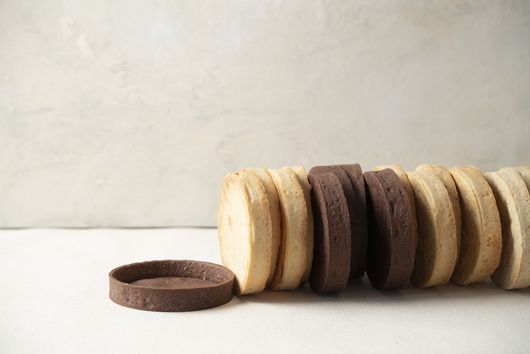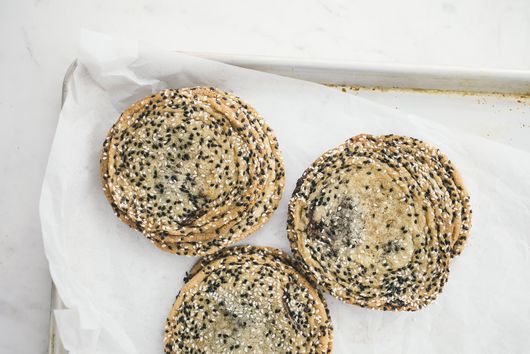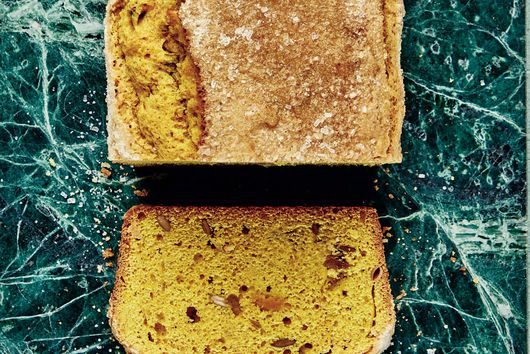Dominique Ansel's Go-To Vanilla Sablé Tart Shell
★★★★★
PREP TIME
30 minutes
COOK TIME
30 minutes
MAKES
one 8-inch (20 cm) tart shell
Ingredients
185 grams
(1 1/2 cups) all-purpose flour, plus more for dusting
85 grams
(2/3 cup) confectioners’ sugar
50 grams
5 1/4 tablespoons cornstarch
1 gram
(1/4 teaspoon) Kosher salt
3 grams
1/2 Tahitian vanilla bean, split lengthwise, seeds scraped
130 grams
(10 tablespoons / 1 1/4 sticks) unsalted butter, cut into cubes, at room temperature
50 grams
(1 large) egg
Instructions
- Make the dough: Combine the flour, confectioners’ sugar, cornstarch, salt, and vanilla seeds in a large bowl. Add the butter and mix with your hands until the butter is broken down into pieces the size of peas and the ingredients are well combined. (Alternatively, use a stand mixer or hand mixer to combine the ingredients.) Add the egg and mix with a spatula until the dough is smooth and the egg is fully incorporated. Don’t overmix.
-
Chill the dough: Turn the dough out onto a large piece of plastic wrap and gently shape it into a ball. Wrap the dough in the plastic wrap and flatten it into a disc. Refrigerate for at least 30 minutes or up to overnight, until cold but still pliable. It should
have the texture of clay. (At this point, the dough can be refrigerated or frozen for later use—see Storage.)
Flattening the dough into a disc will help it chill faster. You’ll want to make sure the dough is cold before rolling it out. Working with dough that’s too warm will cause the tart shell to shrink as it bakes. - Preheat the oven: Place a rack in the center of the oven and preheat the oven to 350°F (175°C).
-
Roll out the dough: Flour your work surface and rolling pin. Unwrap the dough and place it on your work surface. Roll it out into a rectangle about 1⁄8 inch (3 mm) thick. Make sure to work quickly so the dough doesn’t get too warm.
If you find that your dough is sticking to the rolling pin or work surface, add some more flour. Then roll it out between two sheets of parchment paper. Parchment paper also makes it easier to lift the rolled-out dough onto the sheet pan later on. -
Shape the dough: Using an 8-inch (20 cm) tart ring or pan as a guide, cut the dough into a round that’s 1 inch (2.5 cm) wider than the ring (this ensures the dough will come up the sides of the tart ring).
Don’t throw out your dough scraps! Sprinkle them with cinnamon sugar (I make mine with 3 grams (1 teaspoon) of cinnamon to 100 grams (1⁄2 cup) of granulated sugar) and bake them, then enjoy them as buttery sugar cookies or crumbled over your morning yogurt. -
Now the fun part: you’re going to “fonçage” the tart dough (page 282), or form it into a tart shape. (Don’t worry, it’s not as intimidating as it sounds!) Butter the tart ring or pan.
If you’re using a tart ring, line a sheet pan with parchment paper, then set the tart ring in the center (no need to do this if you’re using a tart pan with a bottom). Place the round of dough on top of the tart ring or pan and push down gently with your fingers, pressing the dough along the inside of the ring or pan and into the inside edge. Don’t press too hard, and try to keep the dough an even thickness so that it bakes evenly. Use a paring knife to trim any dough hanging over the sides of the ring or pan.
If your dough is starting to feel warm, return it to the refrigerator for 15 minutes before baking. Remember, warm or overworked dough will shrink as it bakes. If the dough is cool to the touch, you can bake it right away. -
Blind bake the tart shell: Line the tart shell with a round of parchment or a large coffee filter; the surface of the dough should be completely covered. Fill the tart shell with uncooked rice or dried beans to keep the dough in place. Bake on the center rack until the tart shell is light golden brown, 15 to 20 minutes.
Since many tarts are filled with creams or mousses (which aren’t baked), you’ll have to bake the tart shell in advance of filling it. This is called blind baking. Here’s an easy trick to cut a perfect circle: Fold a square of parchment paper in half, then in half again. Fold it in half diagonally to form a triangle, then fold the triangle in half once more. Flip your pan upside down and place the folded paper triangle with the narrow tip at the center of the pan. Using scissors, cut the base of the triangle (the side opposite the tip) into a curve, following the curve of the pan. Unfold the paper: it should now be a circle slightly larger than the tart ring or pan. -
Unmold the tart shell: Cool for 2 to 3 minutes, then unmold the tart shell while still warm (it’s easier to remove from the pan when it’s warm). If you’re using a tart pan with a removable bottom, set the pan on an upside-down pint container or a small bowl and push down gently on the sides of the pan to unmold the tart shell. If you’re using a tart ring, lift the ring up and off the tart shell. Let cool completely before filling. Wait until just before serving to add the filling so the shell stays nice and crispy.
Before you start assembling a cream-filled tart, always make sure the tart shell is fully cooled. If the shell is too hot, the pastry cream will melt and soak into the crust, giving you a soggy-bottomed tart. -
STORAGE
The tart shell is best enjoyed the day it’s baked, but can be stored in an airtight container in a cool, dry place for up to 2 days before filling and serving. The unbaked tart dough can be wrapped tightly in plastic wrap and stored in the refrigerator for up to 3 days or in the freezer for 2 to 3 weeks. Thaw the frozen dough in the refrigerator for a few hours before using.





